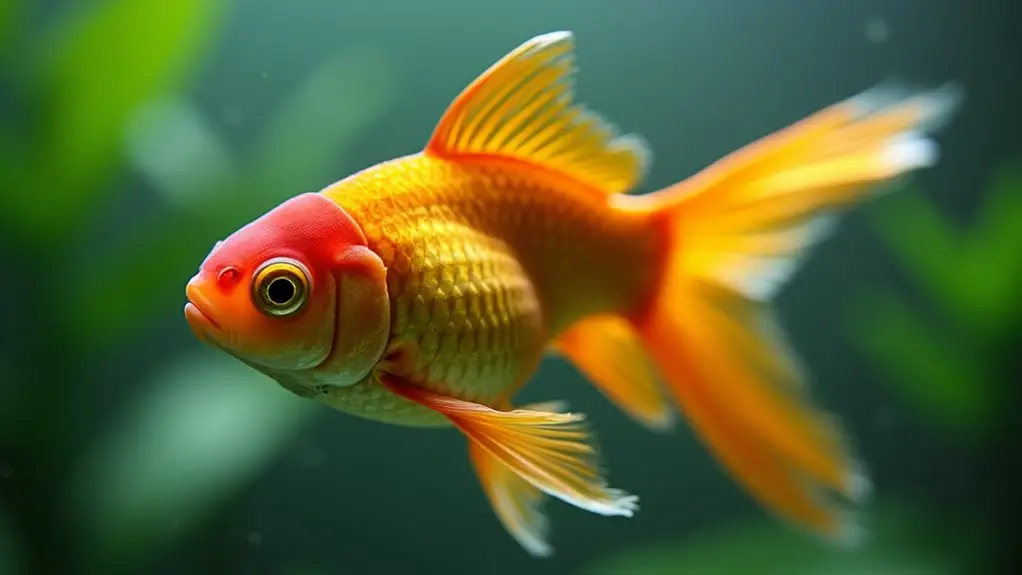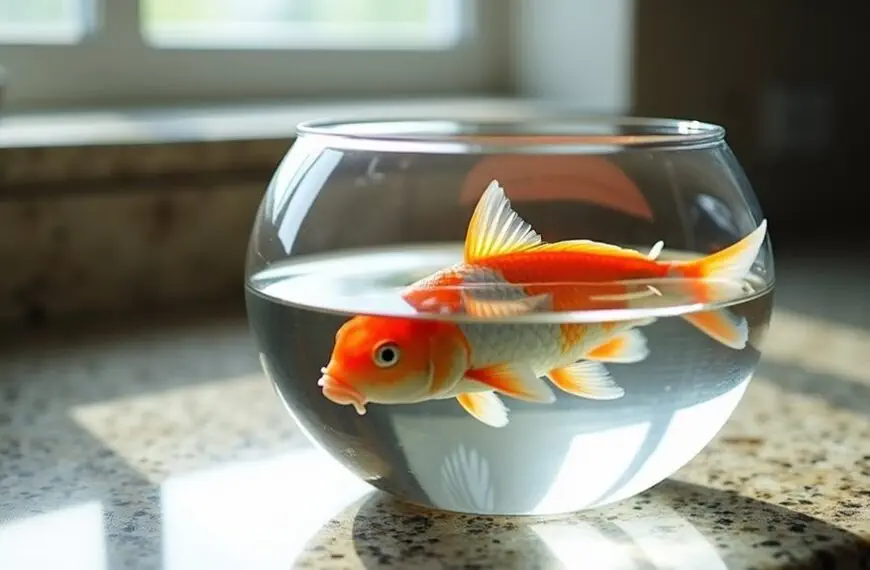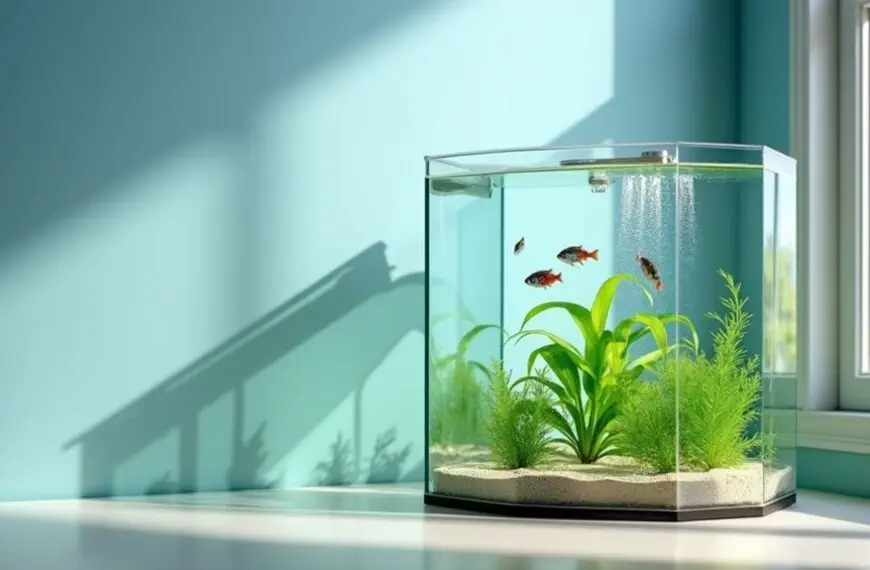Your well-cared-for goldfish can live 10-15 years on average, with some exceptional fish reaching 30-40 years! The record holder, Tish, lived an impressive 43 years. Common goldfish typically outlive their fancy cousins due to better genetics and adaptability, while fancy varieties usually live 5-10 years in tanks and 12-20 years in ponds. Their lifespan largely depends on proper care, including water quality, tank size, and diet. You'll need at least 20 gallons per fish, maintain stable temperatures between 68-74°F, and provide a balanced diet. There's much more to keeping your finned friend swimming happily for years to come.
Contents
- 1 The Average Goldfish Life Expectancy
- 2 Factors That Impact Longevity
- 3 Common Goldfish Vs Fancy Types
- 4 Creating The Perfect Living Environment
- 5 Proper Feeding And Nutrition
- 6 Signs of a Healthy Goldfish
- 7 Avoiding Early Goldfish Death
- 8 Frequently Asked Questions
- 8.1 Can Goldfish Live in a Bowl With Other Small Fish Species?
- 8.2 Do Goldfish Recognize Their Owners and Show Different Behaviors Toward Them?
- 8.3 What Happens to Goldfish's Growth Rate When Kept in Smaller Tanks?
- 8.4 Can Goldfish Survive if the Power Goes Out and Filtration Stops?
- 8.5 How Often Should Goldfish Be Treated for Parasites as Preventive Care?
- 9 Final Thoughts
The Average Goldfish Life Expectancy
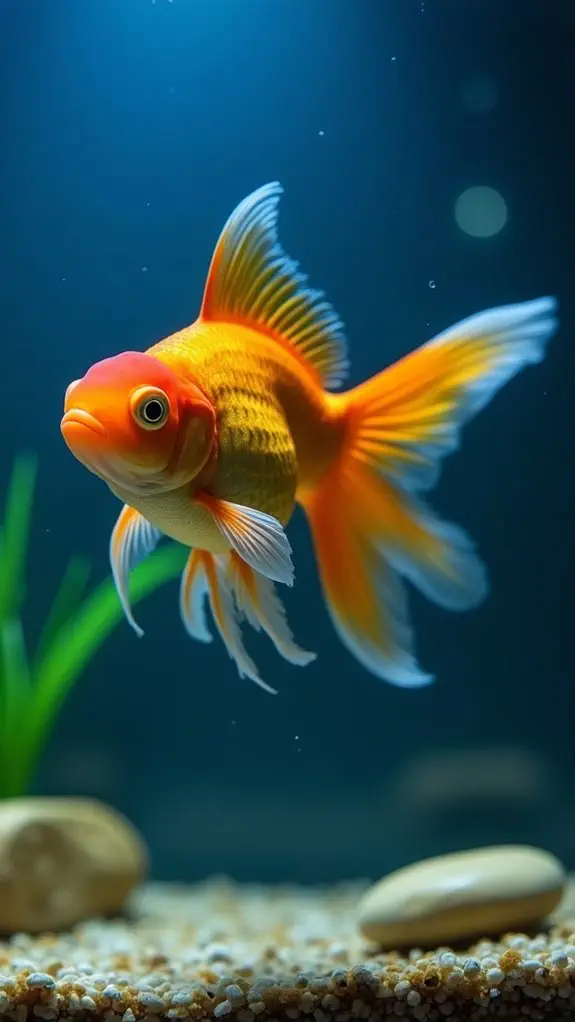
A goldfish's longevity often surprises first-time pet owners who expect these aquatic companions to live only a few years. In reality, the average lifespan of a well-cared-for goldfish ranges from 10 to 15 years, with some exceptional cases reaching well into their 30s and 40s. You might be amazed to learn that the world record holder, a goldfish named Tish, lived to the impressive age of 43! Fancy goldfish breeds typically have shorter lifespans due to selective breeding and genetic factors.
When it comes to goldfish variations, you'll find that different breeds can have significantly different lifespans. If you're considering a common goldfish, you can expect them to outlive their fancier cousins, as they typically maintain better health throughout their lives. Regular water parameter testing is essential to prevent ammonia buildup and ensure optimal health, as stable pH levels can greatly influence their longevity.
Your choice of housing also plays an important role – pond-dwelling goldfish often enjoy longer lives than their tank-kept relatives, thanks to better water quality and more swimming space. It's like comparing life in a cozy apartment to life in the countryside!
Whether you're housing your finned friend in a tank or pond, providing proper care and maintenance can help your goldfish reach its full lifespan potential.
Factors That Impact Longevity
Your goldfish's lifespan depends on several key factors that you'll need to manage carefully, including pristine water conditions and the right tank size.
To keep your finned friend swimming happily for years, you'll want to maintain zero ammonia levels, provide at least 20 gallons of space per fish, and establish a balanced feeding routine that won't pollute their water. Regular water quality testing will help ensure your goldfish reaches its full life expectancy. Maintaining optimal filtration systems is also crucial for supporting a healthy environment. Shubunkin goldfish can live up to 20 years when these conditions are met properly.
Water Quality Essentials
Maintaining proper water quality stands as the cornerstone of goldfish longevity, with poor conditions being the leading cause of premature death. You'll need to become familiar with regular water testing and reliable filtration systems to keep your aquatic friend healthy and happy.
The key is maintaining ideal pH levels between 7.0 and 7.4, while ensuring ammonia and nitrites stay at zero. A minimum tank size of 50 liters helps maintain stable water parameters. A robust filtration system is essential for removing waste and maintaining biological balance.
Think of your goldfish's water as their entire world – it's where they eat, breathe, and, well, do their business! That's why you'll want to perform weekly water changes of 10-25% and keep those nitrate levels below 20 ppm.
Don't forget to treat tap water before adding it to your tank – your goldfish won't appreciate a chlorine cocktail! Temperature stability is essential too, with the sweet spot being 68-74°F.
While goldfish are pretty tough cookies and can handle temperatures from 50-80°F, they'll thrive best in that ideal range.
Tank Size Matters
Size reigns supreme when it comes to your goldfish's longevity, with cramped quarters being a major factor in shortened lifespans. When considering tank requirements, you'll need at least 50 liters for your first finned friend, plus an additional 10 gallons for each new goldfish you add to the family.
Think of it this way: your goldfish needs room to stretch those fins and grow! These amazing creatures can reach up to 38 centimeters in natural environments. Low-maintenance fish are often more resilient and can thrive in suitable tank conditions, making them a great choice for beginners.
Space considerations go beyond just volume – your tank's dimensions matter too. You'll want a length that's at least four times your adult fish's size, with width and height proportionally sized to create a comfortable swimming environment.
It's like giving your goldfish a proper underwater apartment instead of a cramped closet!
You might be surprised to learn that pond-dwelling goldfish often outlive their tank-kept cousins by a significant margin. While tank fish typically live 10-15 years, their pond-dwelling relatives can splash around for up to 25 years!
But don't worry if you can't provide a pond – a properly sized tank with regular maintenance and water changes will still give your goldfish a happy, healthy life.
Diet and Care Guidelines
Beyond tank size, proper diet and care habits directly shape your goldfish's lifespan. Understanding your pet's feeding habits is vital – you'll want to provide a diverse menu that's rich in proteins but low in fats.
Just like humans, goldfish thrive on a balanced diet that includes quality flakes, pellets, and occasional treats like brine shrimp or properly cut vegetables. Including live foods in their diet helps mimic their natural feeding patterns. Your adult goldfish needs about 6% fat content in their diet for optimal health. Additionally, maintaining optimal water conditions can significantly enhance their longevity.
You'll notice positive goldfish behavior when you maintain consistent water quality, which is absolutely essential for their well-being.
Don't skip those regular water changes – replacing 30% of the tank water helps remove harmful toxins that could stress your finned friend.
Keep a close eye on water temperature too, as goldfish prefer it cool, typically between 68-74°F.
While they're surprisingly hardy, they'll show their appreciation for stable conditions through vibrant colors and active swimming.
Common Goldfish Vs Fancy Types
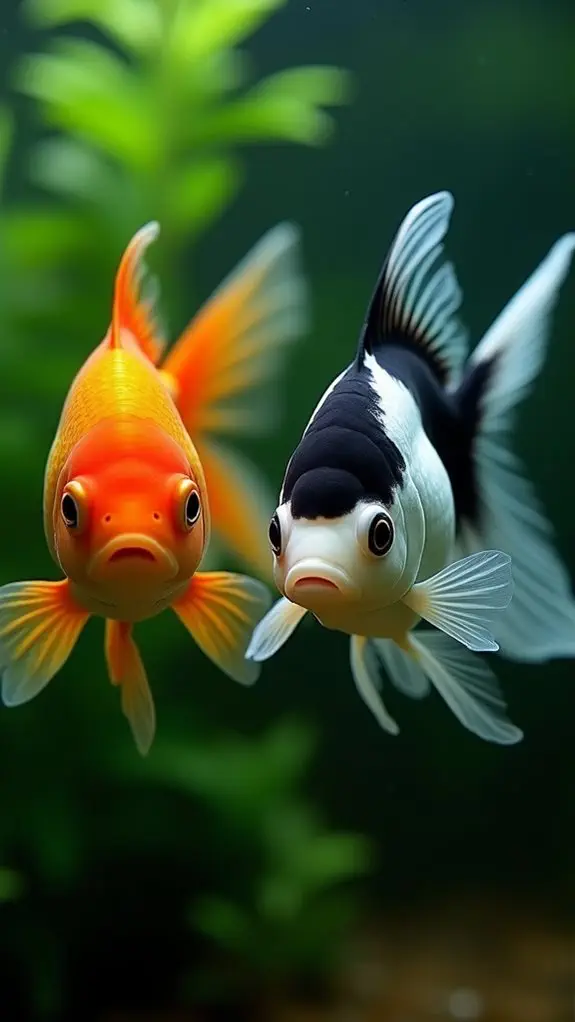
Between common goldfish and fancy varieties, you'll notice significant differences in their expected lifespans. When comparing these goldfish varieties, common goldfish typically live longer, reaching 10-15 years in tanks and up to 25 years in ponds.
In fact, the record holder is a common goldfish named Tish, who lived to an impressive 43 years! For optimal longevity, these fish need a minimum of 20 gallons of water per goldfish. It's also important to monitor water quality regularly, as good filtration is essential for their health.
Fancy goldfish, including beautiful varieties like Fan-Tailed and Oranda, generally don't live quite as long as their common cousins. You can expect them to survive 5-10 years in tanks and 12-20 years in ponds.
This shorter lifespan comparison isn't because they're less hardy (though they're a bit more delicate), but rather due to their selective breeding and compact body shapes.
If you're hoping to help your goldfish reach its full potential, remember that both types thrive in larger spaces. Your common goldfish will especially appreciate a roomy environment, while fancy types need careful attention to water quality.
With proper care, including a varied diet and stress-free environment, you'll be amazed at how long these fascinating pets can live!
Creating The Perfect Living Environment
A perfect living environment plays the most essential role in your goldfish's longevity. When it comes to goldfish habitats, bigger is always better – your finned friend will thrive in a spacious tank with plenty of swimming room and surface area.
Think wide rather than tall, as this design promotes better oxygen exchange and reduces stress on your pet.
You'll want to maintain a stable water temperature, though goldfish are pretty adaptable creatures that can handle quite a range. They're not too picky about the thermometer reading, but they do care about their water quality!
Regular bi-weekly water changes and careful monitoring of pH levels between 6.5 and 8.5 will keep your aquatic buddy happy and healthy. Additionally, establishing beneficial bacteria is essential for effective waste management and reducing toxin buildup in the water.
Consider creating a more natural setup by adding live plants and small pebbles – though don't be surprised if your goldfish treats those plants like an all-you-can-eat buffet!
For the ultimate goldfish paradise, an outdoor pond provides the most natural environment. Just remember, whether you choose a tank or pond, consistent maintenance and regular cleaning are your golden tickets to extending your pet's lifespan.
Proper Feeding And Nutrition
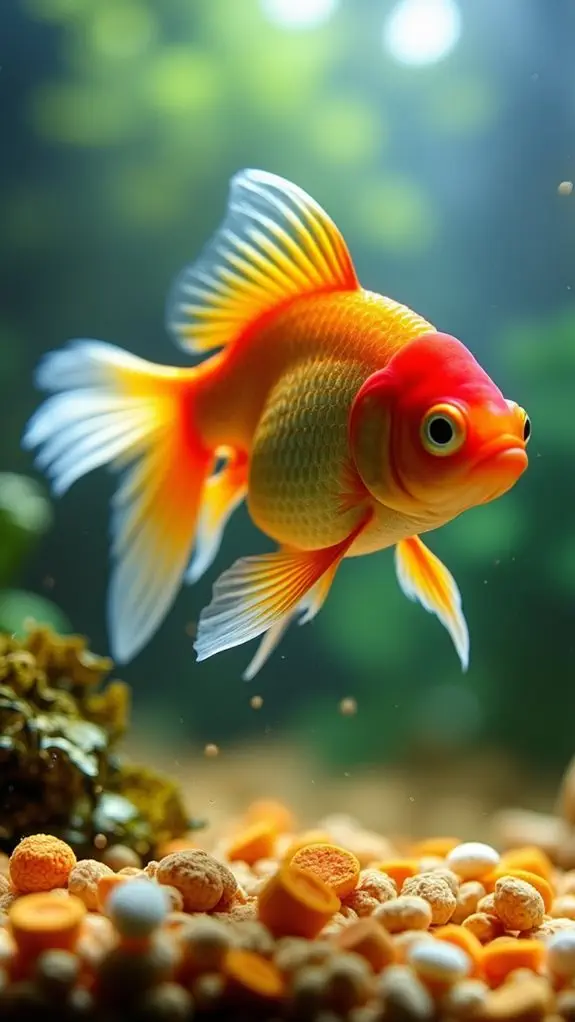
Feeding your goldfish properly can make the difference between a short life and a long, healthy one. Your finned friend's diet should include a mix of high-quality pellets or flakes specifically made for goldfish, along with dietary supplements like fresh vegetables and occasional protein-rich treats.
When it comes to feeding techniques, you'll want to establish a consistent routine of 2-3 small meals per day. Think of your goldfish as a tiny underwater grazer – they'd rather have several small portions than one big feast! You should only offer what they can eat within two minutes, as leftover food can quickly dirty their water.
If you've got young goldfish, they'll need more frequent meals to support their growth, while older fish can handle fewer feedings. In addition, be sure to monitor your water quality regularly, as maintaining water parameters is crucial for their overall health.
Don't forget to mix things up with some healthy treats! Blanched peas, lettuce, and zucchini make excellent veggie options, while freeze-dried bloodworms or brine shrimp can be offered as special treats.
Remember to adjust your feeding schedule with the seasons – they'll eat more during warm months and less when it's cooler.
Signs of a Healthy Goldfish
Knowing the signs of a healthy goldfish helps you catch potential problems early and guarantee your pet's longevity. When you're monitoring your goldfish's health, pay attention to both physical and behavioral indicators that show they're thriving in their environment.
A healthy goldfish will display bright, vibrant scales that catch the light beautifully, and their fins should stand tall and proud, not clamped against their body. You'll notice positive goldfish behavior when they're actively swimming throughout their tank, exploring every nook and cranny like tiny aquatic adventurers.
They should also show excitement at feeding time, keenly eating without spitting out food or struggling.
Your water conditions play a vital role in maintaining these health indicators. Keep the temperature between 68-75°F, and make sure you're performing regular water changes to maintain the best water quality.
If you notice your fish sitting at the bottom, showing dull colors, or breathing rapidly, it's time to check your water parameters and possibly consult a fish veterinarian.
Avoiding Early Goldfish Death

Many goldfish meet an early demise due to preventable mistakes in their care routine. By focusing on stress reduction and creating a healthy environment, you'll give your finned friend the best chance at a long, happy life.
Start by maintaining proper water quality through regular partial water changes, and don't forget to treat tap water with a dechlorinator before adding it to your tank. Maintaining healthy water quality is essential for promoting a stable ecosystem and reducing stress for your goldfish.
Your goldfish's health depends heavily on disease prevention through proper tank maintenance. You'll want to clean the gravel weekly and keep those water parameters in check – think of it as giving your fish a clean, comfy home.
Don't make the common mistake of overfeeding; it's better to feed smaller portions that your fish can finish within a few minutes. And while it might be tempting to squeeze multiple fish into a small tank, remember that goldfish need plenty of swimming space to thrive.
Temperature stability is vital, so avoid sudden changes that could shock your fish.
Keep compatible tank mates only, and you'll create a peaceful underwater community where your goldfish can flourish without the stress of aggressive neighbors.
Frequently Asked Questions
Can Goldfish Live in a Bowl With Other Small Fish Species?
You shouldn't keep goldfish in bowls with other fish species. For proper goldfish compatibility, you'll need a larger tank where you can carefully select suitable tank mates with similar water requirements.
Do Goldfish Recognize Their Owners and Show Different Behaviors Toward Them?
Yes, your goldfish can recognize you! They'll show different behavior patterns toward their owners, often swimming closer, being more active, or responding uniquely when you approach. This illustrates their capacity for owner recognition.
What Happens to Goldfish's Growth Rate When Kept in Smaller Tanks?
Your goldfish's growth will be severely stunted in a small tank. They'll release growth-inhibiting hormones that build up in limited water space, preventing them from reaching their full size potential.
Can Goldfish Survive if the Power Goes Out and Filtration Stops?
Yes, your goldfish can survive a power outage without filtration for several hours. You'll need to maintain water movement manually and use battery-operated aerators. The longer filtration's down, the more critical proper care becomes.
How Often Should Goldfish Be Treated for Parasites as Preventive Care?
You shouldn't routinely treat for parasites without signs of infection. Instead, focus on maintaining excellent water quality and monitoring your goldfish's health. Only treat when necessary to avoid creating resistant parasites and causing stress.
Final Thoughts
You'll find that goldfish can be wonderful companions for many years when you give them the care they deserve. By providing proper tank conditions, balanced nutrition, and regular maintenance, your finned friend could live 10-20 years or even longer! Don't fall for the "disposable pet" myth – with your dedicated care and attention, your goldfish can thrive well beyond those typical few months in a bowl.

